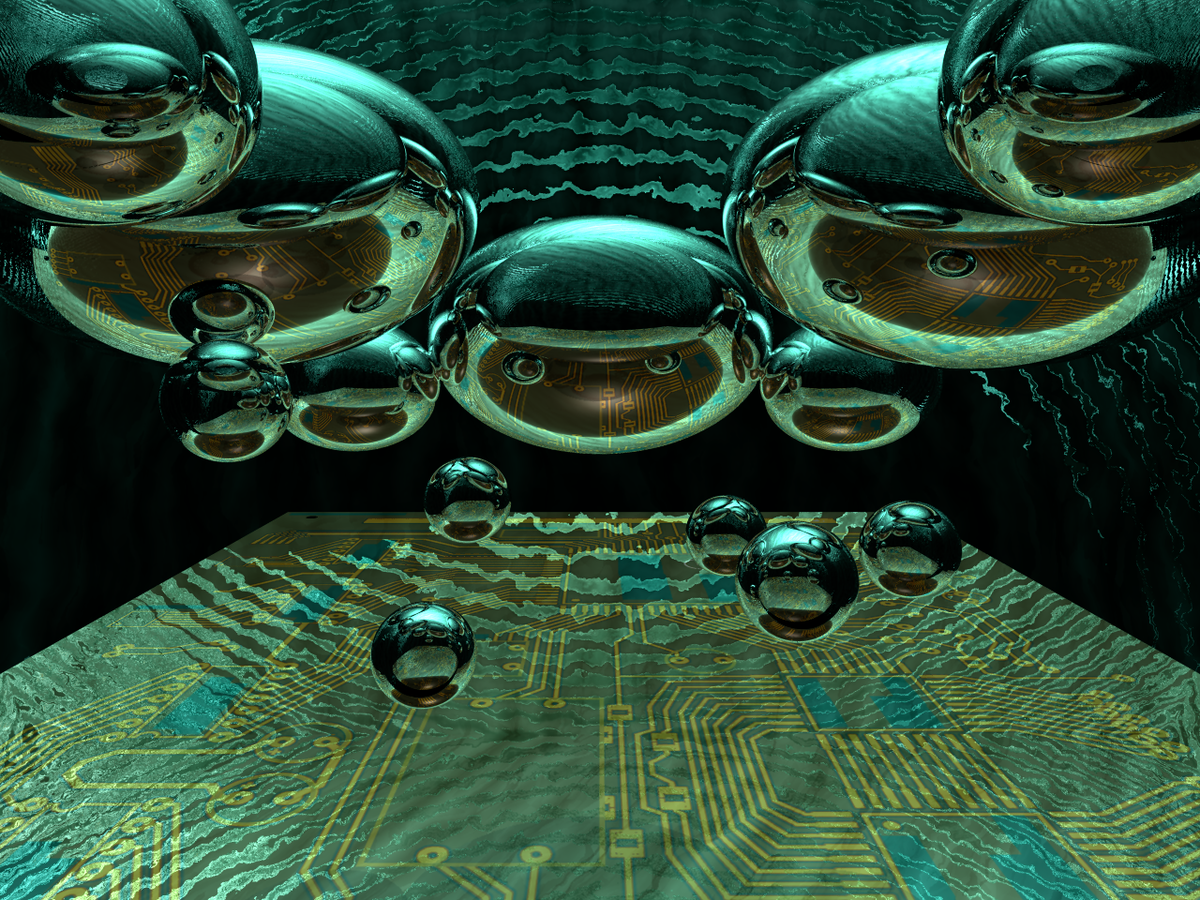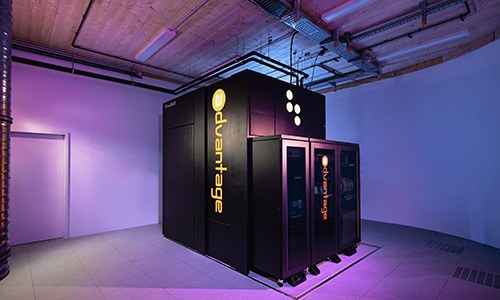Interview: Dr Jaka Vodeb on possible quantum processes in the creation of the world
One of the key questions about the origin of the universe is that of the ‘decay of the false vacuum’. About 50 years ago, the theoretical physicist Sydney Coleman postulated the hypothesis that our universe could exist in a metastable state. The universe may only appear stable, while in fact it could be on the verge of transitioning into the so-called ‘true vacuum’. With potentially devastating consequences. Other theories assume that the false vacuum reached the ground state shortly after the Big Bang and that we already live in the true vacuum.
To get to the bottom of this mystery, which remains unsolved to this day, a team of scientists from the Jülich Supercomputing Centre (JSC) at Forschungszentrum Jülich, the University of Leeds and the Institute of Science and Technology Austria collaborated. They examined the behaviour of particles at the smallest scales using a quantum annealer of the Canadian company D-Wave Systems, Inc. By simulating the false vacuum, they were able to study it in detail. The results of their paper on this have now been published in the journal Nature Physics.
In this interview, first author Dr. Jaka Vodeb (JSC) explains the insights gained and assesses the extent to which they help us to get a little closer to solving the mystery of the origin of the universe.

The formation of the universe, the so-called ‘Big Bang’ has always been subject to intense research. It is a question of both a highly scientific and religious nature that fascinates mankind with its mysteriousness. Do your findings actually explain the origin of the world?
Our findings provide a deeper understanding of the quantum processes that may have occurred shortly after the Big Bang. By simulating false vacuum decay on a quantum annealer, we modeled a phenomenon that is believed to be a key aspect of the early universe’s dynamics.
In your paper, you refer to the so-called ‘false vacuum’. What is the difference between a ‘true’ and a ‘false’ vacuum?
A true vacuum represents the state of lowest possible energy in a system, where everything is stable and at equilibrium. A false vacuum, on the other hand, is a metastable state—a state that appears stable but can decay into the true vacuum through quantum tunneling or other processes. This decay involves the formation of “bubbles” of the true vacuum, which grow and consume the false vacuum. A good analogy exists where temperature takes the role of quantum effects: the everyday example of supercooled water that instantly freezes when you hit the bottle containing it, which anyone can easily find on YouTube. The supercooled water is the false vacuum and the ice is the true vacuum. We studied the quantum version of this phenomenon on the quantum device.
In what way exactly is the ‘false vacuum decay’ process related to the formation of the universe?
False vacuum decay is believed to have played a role during the early universe, shortly after the Big Bang. As the universe expanded and cooled, it may have settled into a metastable false vacuum state, where all the fundamental particles that we know – electrons, quarks, … - had different properties, such as their masses and how they interact. In this version of the Universe, the atoms that make up all of us may not have been possible. Over time, regions of true vacuum could have formed and grown, triggering a phase transition that influenced the universe’s structure and the forces governing it. On the other hand, we could still be living in a false vacuum, where the atoms comprising us are possible and it might happen that the Universe might still transition to a different version of itself, the true vacuum, where our existence is not possible. Studying such processes is therefore key to understanding if and how this could happen.
That sounds as if we had to doubt or fear for our own existence. Assuming that this were actually the case, how long do you think such a transition would take? Are we talking years, centuries, millennia?
Thetimescales involved are extraordinarily long, making it highly unlikely to happen within our lifetimes. It is kind of like worrying today that in a few billion years our Sun will consume the Earth. So while it does sound dramatic, there is no need for actual concern. Moreover, it is possible that all false vacuum decays already occurred during the early Universe, meaning we are already in a stable vacuum state.
Let's stick with this thought experiment. What would it look like in theory? Would our planet and everything on it gradually disappear into thin air’? Or would it be more of a bang, like a second Big Bang, with the effect that all life would suddenly disappear? Can we even tell?
In theory, it would probably look quite daunting. As early as in the 1980s, there was a theory that someone looking at it from the outside, would perceive a black hole expanding at the speed of light. It is comforting to know that the ‘consumption’ of the Earth would happen so quickly that we would hardly notice. Nevertheless, no one wants to imagine discovering a looming black hole heading straight for us. Fortunately, we have not observed any such black hole – yet.
As scientists, how likely do you think it is that so-called ‘bubbles’ of the real vacuum form in the background of the false vacuum and interact with each other? Or to put it another way: Do you believe in that one giant bubble destroying everything at one point?
The formation of a single giant bubble is theoretically possible, but the likelihood is exceedingly small. Quantum mechanics predicts that any transition from a false vacuum to a true vacuum would begin with small, localized bubbles, which would need specific conditions to grow and interact. The probability of such a cataclysmic event happening is so low that it remains purely theoretical.
What are the arguments in favour of the false vacuum reaching its ground state shortly after the Big Bang and us already being in a real vacuum – so safe, in a sense?
If you take a look at the best model of the Universe we have so far – the Standard model – there is a good chance that we are observing particle masses that already represent the true vacuum.

The calculations were carried out at the Jülich Supercomputer Centre with a quantum annealer that is connected to a classical supercomputer. Why was the combination of these two very different types of computers so valuable and how did the experiments specifically benefit from it?
The quantum annealer excels at simulating quantum systems with many interacting qubits, allowing us to study dynamics that are inherently quantum mechanical. However, interpreting the results and validating the observations requires classical supercomputers. They provide the computational power to run numerical simulations that help understand the data produced by the annealer. This hybrid approach combines the strengths of both technologies to gain insights that neither could achieve alone. An added advantage is that the experiments using this hybrid approach could benefit from access to JSC's supercomputers and the D-Wave quantum annealer hosted by JSC's quantum computing facility JUNIQ.
How does that work exactly: Do we see the events of the universe as they could actually have happened – and with the help of the quantum annealer, as if through a time-lapse camera?
In a sense, yes. The quantum annealer allows us to simulate the dynamics of false vacuum decay as they might have occurred in the early universe. While it’s not an exact time-lapse, the annealer lets us observe key aspects of the process, such as bubble formation and interactions, in a way that provides snapshots of what might have transpired during this critical phase of cosmological evolution.
With a D-Wave quantum annealer, you created the metastable state of the false vacuum – what did you observe, how did the bubbles behave and interact – and more importantly, what conclusions did you draw from this?
We observed that bubbles of the true vacuum formed within the false vacuum, their size dictated by the difference in energy between the true and false vacuum states. The bubbles interacted in complex ways, with the smallest ones running freely around the system, bumping into each other, whereas the larger bubbles could only grow by interacting with a neighbor and shrinking it in the process. The conclusion was that the interaction between bubbles is key in their growth, without it they are frozen in space. This was never observed before.
To what extent are the results a milestone in the exploration of the universe?
These results represent a significant milestone in understanding quantum phenomena linked to the early universe. For the first time, we’ve used a quantum annealer to observe false vacuum decay dynamics, demonstrating the practical application of quantum computing to cosmological problems.
For what other research are the results relevant?
The results are relevant not only to cosmology but also to condensed matter physics, quantum field theory, and materials science. They open new possibilities for studying phase transitions, metastable states, and energy-efficient quantum devices. This research could also inform the development of quantum technologies and help us tackle problems in cryptography, optimization, and beyond.
As this was a collaboration between JSC at Forschungszentrum Jülich, the University of Leeds and the Institute of Science and Technology Austria (ISTA), which of the institutions took on which task exactly?
This was a collaborative effort involving Forschungszentrum Jülich, the University of Leeds, and ISTA. At Jülich, we focused on configuring and running the experiments on the D-Wave quantum annealer, leveraging its unique capabilities to simulate the dynamics of the false vacuum. ISTA contributed their expertise in theoretical quantum physics, helping to analyze the fundamental mechanisms behind vacuum decay and bubble interactions. Meanwhile, the University of Leeds provided advanced numerical emulation techniques to compare the quantum annealer’s results with classical simulations, ensuring a robust understanding of the observed phenomena.
You were very susscessful together. Will the collaboration continue?

Definitely. The joint research was very exciting due to different areas of expertise coming together that provided new insights neither of us could have gained alone. I particularly enjoyed how the annealer was the initial trigger of our research. If we hadn’t stumbled upon quantized bubbles of the true vacuum by chance, we wouldn’t have done any of this. That’s also the main reason why we are already working on the two-dimensional version of false vacuum decay. And we already have some very interesting results.
About D-Wave
D-Wave is a pioneering company in quantum computing, specializing in quantum annealers—devices designed to solve optimization problems and simulate quantum systems efficiently. Their systems utilize thousands of superconducting qubits arranged in a highly interconnected lattice, enabling the study of complex quantum phenomena.
About JUNIQ
JUNIQ - Jülich Unified Infrastructure for Quantum Computing - is a state-of-the-art research platform at JSC, Forschungszentrum Jülich, that integrates quantum hardware, such as D-Wave’s quantum annealers, with classical high-performance computing resources. This combination provides researchers with a powerful infrastructure to tackle computationally challenging problems, ranging from material science to cosmology, and push the boundaries of quantum research.
Further Information
Original Publication:
Vodeb, J., Desaules, JY., Hallam, A. et al. Stirring the false vacuum via interacting quantized bubbles on a 5,564-qubit quantum annealer. Nat. Phys. (2025). https://doi.org/10.1038/s41567-024-02765-w
See also the corresponding FZJ News and the Press Release of the University of Leeds: Quantum machine offers peek into “dance” of cosmic bubbles
For more information on JUNIQ, please visit: JUNIQ-Infrastruktur
Contact: Jaka Vodeb (JSC), Prof. Dr. Kristel Michielsen (JSC)
